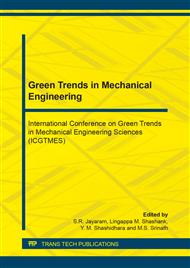p.83
p.90
p.96
p.102
p.109
p.115
p.122
p.127
p.134
Experimental Studies of Biogas in a Single Cylinder Diesel Engine by Dual Fuel Mode of Operation
Abstract:
The aim of this work is to examine the performance, combustion as well as emission characteristics of diesel engine performed for various mixtures of methane-enriched biogas (95% CH4). Experiments were performed on a single cylinder, four-stroke constant speed, direct injection, water-cooled diesel engine. The engine is operated by means of dual fuel mode using diesel and different mixtures of methane-enriched biogas (BG) like BG10, BG20, BG30, and BG40 mixed with the air (i.e. BG40-40% of CH4 by volume respectively) for different loads and at injection timing of 27.5° before top dead centre (bTDC). The performance, combustion and emission characteristics of the engine operated by dual fuel mode were experimentally analyzed, and compared with respect to diesel mode. The experimental result reveals that better performance and lower emissions were observed for BG40 compared to other mixtures. The brake thermal efficiency of BG40 is lower by 2.43% compared to diesel at full load. The cylinder peak pressure for dual fuel mode is higher by 6.55% when compared with diesel mode. NOx emission reduced by 2.6 % and CO emission increased by 3.3% compared to diesel at full load respectively. Keywords: Biogas, Energy, Combustion, Emission, Injection timing, dual fuel mode
Info:
Periodical:
Pages:
109-114
Citation:
Online since:
November 2019
Authors:
Keywords:
Price:
Сopyright:
© 2019 Trans Tech Publications Ltd. All Rights Reserved
Share:
Citation:



